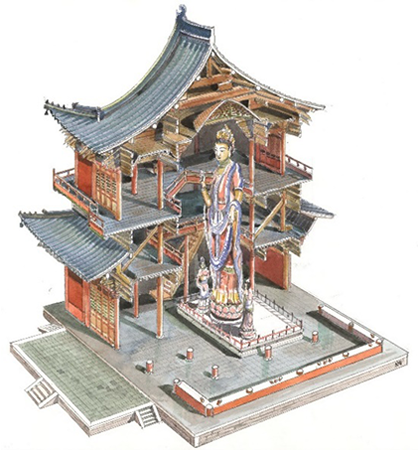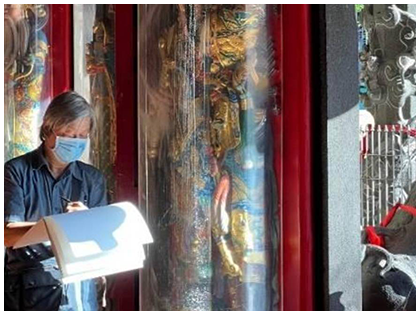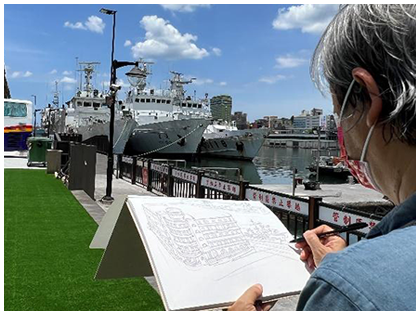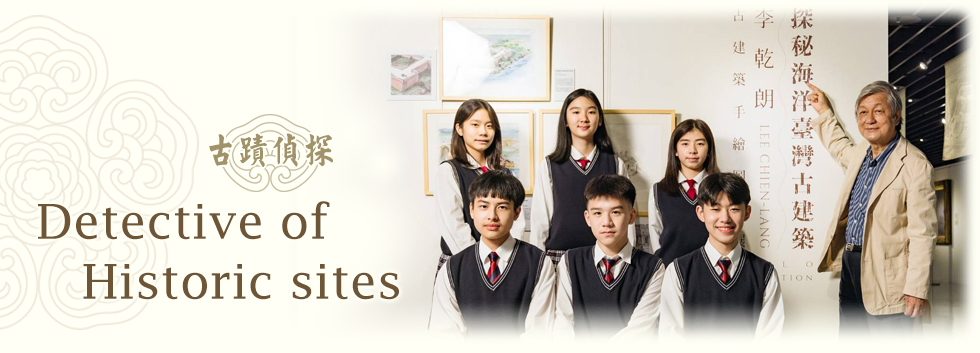Organized by Edward Lu
Master of Historic Sites Color Painting
Professor Li Chien-Lang is famous for his unique architectural perspectives and superb drawing skills. His drawing layouts and techniques are ingenious, from drafting to alignment and coloring, he can demonstrate the beauty of the buildings in simple lines. He utilizes the bird’s-eye view and also dissects buildings with a cross-section to show their structure and internal designs clearly. With dotted and uneven lines capturing aspects such as distance and lighting, his paintings showcase the “blueprint” for the building, and he has effectively established his own style of drawing. Since 2005, he has used this unique style of drawing to paint hundreds of traditionally styled buildings. In the process, Professor Li visits each building in person to sketch out the most accurate representation of the buildings. According to Professor Li, without first-hand experiences, it is impossible to fully understand and acknowledge these traditionally styled buildings’ true complexity and beauty.

Deconstructed Roof Perspective View of Chen Zhonghe House, Kaohsiung
Source: Professor Li Chien-Lang

Deconstructed Perspective View of Guanyin Pavilion in Dule Temple, Hebei
Source: Professor Li Chien-Lang
Professor Li started drawing at a very young age. When he was a child, his father taught him to draw with chalk on the ground of a construction factory where his father worked. Over time, his drawing skills improved, and after entering elementary school, he became the best artist in the class. He learned painting from the senior Taiwanese painter Chen Jin-Hui during his student years. Chen is a descendant of the famous Rev. George Leslie Mackay, and a famous painter who studied in Kyoto, Japan. Chen specialized in intricate gouache paintings. Professor Li’s drawing style was deeply influenced by Chen’s Tamsui Church sketches and watercolors. In addition, he participated in sketching clubs during his high school years. He said that he often ran to the suburbs with only a painting bag and water bottle to practice his art skills, and such practice honed his drawing skills to the maximum.

1974 Temple Sketching
Source: Professor Li Chien-Lang

2022 Field Survey (Keelung/Harbor)
Source: Professor Li Chien-Lang
The first time Professor Li met his mentor, Shiy De-Jinn, was in the autumn of 1972. Shiy was teaching an art class at the Department of Architecture of Tamkang University. In that class, he gave a public speech to people from the Department of Foreign Affairs, and he was talking about ancient architectural designs. Professor Li immediately went to attend his lecture and listened with great interest. Shiy influenced Li greatly, introducing him to the keen observational skills of a painter, such as paying special attention to the details, colors, and shapes of ancient buildings. Shiy stated that black is the main color of ancient buildings in Taiwan, so he later painted ancient houses with special emphasis on the use of ink. He then put forward the statement that the variation of the lines reflects the age of the building. All the old buildings have more blunt and rough lines, while the lines of the more recent buildings are smooth and lively.

In 1975, Li Chien-Lang and Shiy De-Jinn went to Nanfangao Harbor, Yilan for field investigation / Source: Professor Li Chien-Lang

2016 Drawing for the exhibition (research room)
Source: Professor Li Chien-Lang
Professor Li once said: “Architecture is a man-made creation, and materials are gathered and assembled to form the building by workers. Through the cross-sectional view, readers can understand the power and mystery of their assembly, and even imagine the process of construction. This philosophy plays an important role in our understanding and appreciation for architecture.” Such unique architectural perspectives require the use of partial slices, or different angles such as the bird’s-eye view, to present the details of the interior of the building, and to pull out thin lines to fully depict the magnificence of the building. The text descriptions and labels present and describe the internal structures and the materials that construct them in full detail. It portrays an amazing and unknown interior scene that cannot be observed from the exterior of the building. It is thus like “deconstructing” an ancient building so that viewers can grasp the complexity and structures of the interior design with full understanding.
- https://www.kindomliving.com.tw/?p=11895
- https://m.ylib.com/book/TW016
- https://www.ylib.com/author/lan/lan_f.htm
- https://www.evergreenmuseum.org.tw/?moj=news_detail&_sn=125
- https://www.books.com.tw/products/00109304

